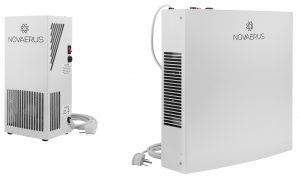Air and Surface disinfection – keeping your staff and your patients safe!
Featured Products Promotional FeaturesPosted by: Dental Design 2nd March 2021

Every dental practice is different. Indeed, whether it’s the number of rooms in the building, the size and dimensions of these spaces or the equipment and other systems used, each dental practice has a unique identity.
As such, the demands for each dental practice when it comes to aspects such as infection control will be different too. This means that professionals need to really think about how to best disinfect their environment, especially as certain design aspects may make infection control less simple than it seems.
Surfaces types
One of the primary things you should do when you look around your practice is evaluate the different surfaces that you have. From metal to plastic, soft furnishings to glass, every surface harbours pathogens differently, meaning that you need to bear this in mind when it comes to disinfection.
Rough and porous surfaces are likely to harbour more bacteria as there are small crevices and places that cleaning products may not be able to reach effectively. For example, natural materials such as wood often have small cracks and other physical features that mean pathogens can avoid being destroyed by cleaning products. You may have heard that your chopping board at home harbours more bacteria than a toilet seat, which is exactly because of this reason – the notches in the wood are difficult to effectively clean.[i]
Of course, it’s unlikely that your dental practice will have many surfaces made of wood, but the same concept applies to soft furnishing and other surfaces that aren’t smooth and easy to wipe clean.
Even smooth surfaces interact with pathogens differently. For example, the Coronavirus responsible for the pandemic has been found to survive longer on some smooth materials than others. When tested, the virus only thrived for 4 to 8 hours on aluminium. However, on glass, an equally smooth surface, it was found that the virus could live for as long as five days. Plastic and stainless steel, both of which are common in dental practices, harboured the virus for up to 3 days.[ii]
In light of this, it’s really important to ensure you are using cleaning products that work effectively on all types of surface, otherwise you may be putting patients and staff alike at unnecessary risk.
What about the air?
It is not just the surfaces around dental practices that need to come into consideration. Dental environments are frequently exposed to high levels of contaminated indoor air. The aerosols generated during routine dental procedures are known to carry significant levels of microbial contaminants and blood.
 Infectious aerosols can be extremely small (<5 µm) and remain suspended and viable in the air stream over long periods of time, resulting in a high risk of airborne infection. The larger infectious particles drop from the air to contaminate surfaces and hands.
Infectious aerosols can be extremely small (<5 µm) and remain suspended and viable in the air stream over long periods of time, resulting in a high risk of airborne infection. The larger infectious particles drop from the air to contaminate surfaces and hands.
One great option is to invest in an air disinfector like one of the Novaerus air disinfection units from Eschmann. Novaerus air disinfection units use patented NanoStrike plasma technology that safely kills and deactivates all airborne microorganisms on contact, providing the first line of protection against viruses and bacteria. With no harmful by-products, Novaerus plasma technology is safe for continued 24/7 use around even the most vulnerable.
Backed by scientific evidence, the Novaerus has been independently tested to reduce MS2 Bacteriophage, a commonly used surrogate for SARS-CoV-2 (COVID-19).
The Novaerus air disinfection units are available in two sizes, NV200 or NV800, with no installation, maintenance or replacement filters required.
For more information on the highly effective and affordable range of infection control products from Eschmann, please visitwww.eschmann.co.uk or call 01903 875787
[i] BBC FOOD. Is Your Kitchen Harbouring More Germs Than Your Loo? Link: https://www.bbc.co.uk/food/articles/kitchen_hygiene [Last accessed December 20].
[ii] WebMD. How Long Does Coronavirus Live on Surfaces. Link: https://www.webmd.com/lung/how-long-covid-19-lives-on-surfaces [Last accessed December 20].








